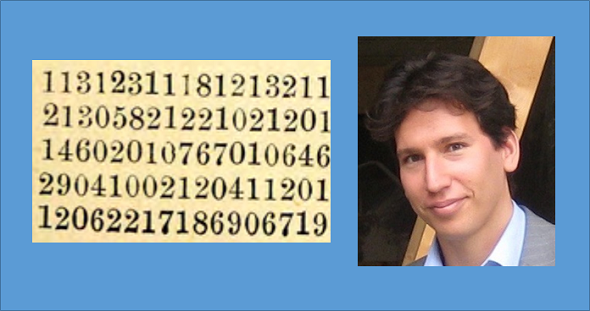130 years ago, Briton Alfred Janes published a self-invented encryption method along with a challenge cryptogram. My blog readers could solve this tricky mystery.
“I beg to submit the following cipher to cryptographers of all nations […], solutions are respectfully invited”, wrote Briton Alfred Janes in 1888 (thanks to blog reader Knox for the hint). I don’t know if any encryption experts of the late 19th century followed his call, but at least I did. I published a blog post about Janes’ crypto challenge in July this year.
The Lockstitch cipher
Alfred Janes (1840-1907) was mainly known as a shorthand expert. He wrote two books about this subject. As it seems, he was also interested in cryptography. In 1888 he published a description of a self-invented encryption method, which he called “Lockstitch cipher” (named for the most common mechanical stitch made by a sewing machine). The Lockstitch cipher uses substitution tables like the following:
A: 65 B: 3 C: 345 D: 41 E: 53 F: 98 G: 163
H: 34 I: 93 J: 67 K: 45 L: 6 M: 10 N: 30
O: 34 P: 57 Q: 901 R: 46 S: 36 T: 88 U: 36
V: 47 W: 94 X: 36 Y: 30 Z: 8
The digit “2” does not appear in this table, it is used as separator. The plaintext CRYPTO accordingly encrypts to 345246230257288234.
A longer text encrypted with such a table is easy to solve by frequency analysis or word pattern search. Janes was aware of this, so he proposed to choose a new table for each letter of the plaintext (also the number used as the separator can vary, and there may be two different numbers used as separators). This means that Janes anticipated a key feature of the later invented One Time Pad.
If applied properly (i.e. with many different tables), the Lockstitch cipher is very secure, but also quite cumbersome. The encoder has to deal with a large set of tables, which must be known to the decoder, too.
The Janes cryptogram
At the end of his paper, Janes presents the following cryptogram:
Along with this encrypted text, Janes writes: “In conclusion, I beg to submit the following cipher to cryptographers of all nations, informing them that it is not a ‘lockstich’ cipher, though taken taken from more than one alphabet, and that it enshrines ordinary English words. Solutions are respectfully invited.” Janes’ writing suggests that he used a few tables like the one above, but not a different one for every cleartext letter.
The solution
My article about the Janes cryptogram generated a lot of interest. Not less than 71 reader comments came in. Comment #50 by reader Marc proved to be especially interesting. Marc suggested that Janes had used four substitution tables with two separators each:
Table 1 (separators: 3, 8)
11(3)12(3)111(8)121(3)211(3)161(3)010(8)161(8)11(3)
100(3)000(8)0(8)121(3)100(8)5(3)121(3)05(8)
Table 2 (separators: 1, 6)
2(1)22(1)02(1)20(1)22(1)02(1)020(6)0(1)5(1)3(1)4(6)5(6)02(1)7(1)5(1)20(6)22(6)02(6)2(1)
4(6)020(1)07(6)70(1)0(6)4(6)40(6)2(1)
Table 3 (separators: 2, 4)
1(2)01(2)6(4)3(4)0(2)5(4)7(2)01(4)09(2)90(4)100(2)1(2)0(4)11(2)01(4)00(2)010(4)
Table 4 (separators: 1, 6)
20(6)4(1)9(1)09(61)9(61)9(1)07(1)02(6)4(6)09(6)20(1)20(6)22(1)7(1)8(6)90(6)7(1)9(1)22(6)
02(6)020(1)
Marc was on the right track. Four days later Dr. Christoph Tenzer, an astronomer at the University of Tübingen, published the solution in comments #59 and #65.
Christoph found the following cleartext:
I SHOULD LIKE TO KNOW
WHETHER ANYONE IN THE WORLD
IS INGENIOUS AND LUCKY ENOUGH
TO PUZZLE OUT THIS CIPHER
The first line is encrypted with table 1 (separators: 3, 8), the second line with table 2 (separators: 1, 6) and so on. Table 1 looks as follows (the other tables can be easily derived from the plaintext):
A: ? B: ? C: ? D: 010 E: 000 F:? G: ? H: 111 I: 11 J:? K: 100 L: 161 M: ? N: 5 O: 121 P: ? Q: ? R: ? S: 12 T: 0 U: 211 V: ? W: 05 X: ? Y: ? Z: ?
Thanks and congratulations to Marc and Christoph for this great piece of cryptanalysis! Thanks also to all other readers who wrote comments. After almost 130 years this mystery is solved.
Follow @KlausSchmeh
Further reading: Who can make sense of a child murderer’s encrypted notes?





Letzte Kommentare